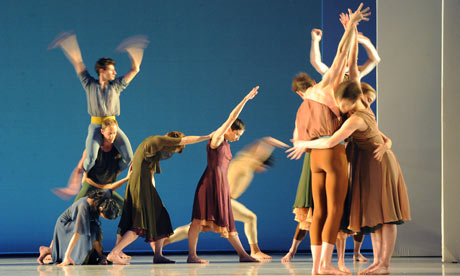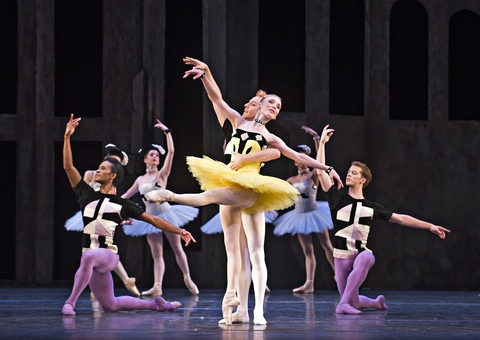L'Allegro, il Penseroso ed il Moderato was choreographed by Mark Morris in 1988, and is perhaps the supreme expression of late 20th-century American modern dance. To music by Handel and poetry by John Milton, and inspired by illustrations by William Blake, Morris has created a detailed and endearingly quixotic hymn to humanism and enlightenment.
We open in darkness, from which rises the voice of a tenor (Mark Padmore), singing of "horrid shapes, and shrieks, and sights unholy". Cobwebby threads of movement follow as dimly lit figures run across the stage, and slowly the lights come up on the first of the work's 32 danced sections. Morris's company are of diverse shapes, ages and ethnic backgrounds, but united by an acute musicality and by filmy Grecian costumes which, in a sense, are foreign to all of them. The opening scene could as easily represent the birth of modern America as the gathering of cosmic order.
Through choreography of deceptive simplicity, Morris creates whole architectures of human experience. Intersecting washes of movement cross the stage, resolving themselves into tableaux in which dancers become nymphs, gods, dogs, fools and much else. There, flying past, are the Muses, the three Graces, Orpheus and Eurydice. Often, as when Julie Worden becomes a spray of silver flute-notes, the dancers are simply representations of Handel's music. Utopia, in Morris's hands, is a house of many rooms.
By contrast, Frederick Ashton's Cinderella, choreographed in 1948 and revived last week by the Royal Ballet, steers an uncertain path between the sublime and the ridiculous. The sublime is represented by some of the loveliest choreography Ashton ever brought to the stage; the ridiculous by the campery of the Ugly Sisters. This, at the time, was the answer to the uneasy question of the physically imperfect woman in a balletic context: isolate her from the main action and have her represented by a man. A generation later, it's fascinating to see how Morris deflates the issue by presenting a company of dancers in which female, and indeed male, imperfection is simply not an issue. Real people are far from perfect, and his dancers are real people. That this in no sense disqualifies them from representing idealised beings goes without saying, but Cinderella demonstrates the subconscious level of anguish that once surrounded the idea.
In Act 1, Alina Cojocaru is a heart-breaking Cinders, visibly missing her dead mother, and dreaming hopelessly of love as she dances, her spirit surging to Prokoviev's music, with her broom. But the poignancy of her situation is undercut by the Uglies (Luke Heydon and Wayne Sleep). Sleep, mugging outrageously, doesn't so much steal the scene as inflict grand larceny on the whole production. It's funny, but the laughs come at the expense of the story. If her stepsisters are just harmless crazies, what has Cinderella got to escape from?
Enter Laura Morera as the Fairy Godmother. Morera has a no-nonsense way with a wand that reminds you of the better sort of hospital matron. The magic that she delivers is time-sensitive and comes with a message: this is your moment, seize it. And in Act 2 Cojocaru does just that, stepping transfigured and wide-eyed into the ballroom and the orbit of her prince (Rupert Pennefather). Their subsequent duet is traditional romanticism incarnate. With his sunny nobility and exquisite stage manners, Pennefather is the perfect match for the nervy, delicate Cojocaru. Like Morris, and subject to the laws of time, he really does seem to promise happy ever after.











